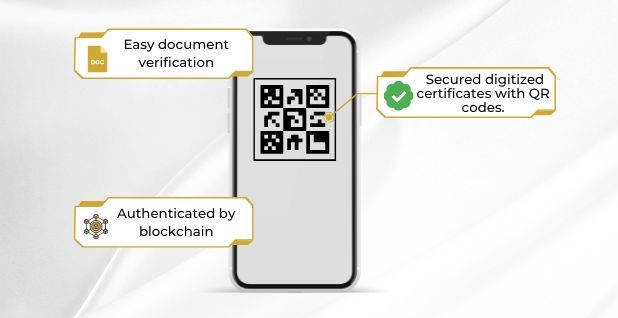Blog

How Verification Ensures Authenticity and Stops Certification Fraud
Have you ever wondered if that diploma online is genuine or if that new doctor you found attended medical school? Verifying credentials could be a hassle, and that's where certificate validity comes in! Think of it as a digital thumbs up from a trusted source. In this blog we will discuss blockchain-based certifications in detail.What is Blockchain?
Imagine a digital record book shared across a network of computers, constantly updating and tamper-proof. That's blockchain in a nutshell. Unlike traditional systems controlled by a single entity, blockchain is decentralized, with everyone on the network holding a copy of the record.
Data is grouped into blocks, linked together like a chain. Each block contains information and a unique code referencing the block before it. This creates a secure timeline, where altering one block would require changing everything that follows – nearly impossible thanks to the network's power.
Think of it like a shared Google Doc, constantly updated but with everyone having a copy and the ability to see any changes. This transparency and security make blockchain ideal for applications where trust is key, from cryptocurrencies to secure record-keeping.
Blockchain Technology Making Change in Verification of Certifications
Earlier checking credentials was more about calling schools or institutions for verification. Blockchain technology is changing that by making verification fast, secure, and accessible to everyone. Imagine a giant, tamper-proof record book where all these credentials are stored. Anyone can access this book using a unique code, like a QR code or a special ID.
For instance, you're applying for a job and your resume boasts a fancy certificate. The potential employer can use the certificate's unique code to log into the secure system and instantly verify if it's legit. No more waiting on phone calls or worrying about forgeries!
This secure system relies on something called a Certificate Authority (CA). Think of a CA as a high-security stamp of approval. When a CA issues a certificate, it's like saying, "Yes, this person earned this credential." Just like a driver's license has your photo and information, a CA certificate has details about the CA itself, including a special digital key. Anyone can use this key to double-check the validity of any certificates issued by that CA.
CAs can be big companies like VeriSign or Certs365. Either way, their certificates act as a digital handshake, ensuring trust and transparency in the world of online credentials.
How Blockchain-Based Certification Works?
These certificates are just like the ones you might hang on your wall, but they use blockchain technology to make them super secure and nearly impossible to fake. Blockchain is like a digital record keeper, constantly watching over the information and making sure no one tampers with it.
Here's how it works:
Blockchain technology revolutionizes credential verification with its tamper-proof design. Here's why it's secure:
- Decentralized Network: No single authority controls the network. Validation and record-keeping are spread across a global network of computers, making large-scale manipulation difficult.
- Consensus Mechanisms: Adding new blocks requires agreement from the network. Mechanisms like Proof of Work make tampering computationally expensive.
- Cryptography: Blockchain uses cryptography to link blocks together. Changing data requires altering all subsequent blocks, a near-impossible feat.
- Immutability: Data once entered remains unchanged. The longer it is on the blockchain, the more secure it is.
- Transparency: A lot of blockchains are public, hence anyone can access transaction history. This makes it easy to notice any inconsistencies or attempts at altering the information transmitted through a blockchain platform.
- Distribution: Copies of the blockchain ledger are stored across multiple nodes. If data is compromised on one node, it can be corrected using data from others.
Verifying Credentials on the Blockchain
Here's how to check a certificate's validity:
- Access a Blockchain Explorer: Use a web-based tool to view blockchain data. Some institutions offer dedicated verification services too.
- Locate the Certificate Record: Find the unique identifier or transaction hash associated with the certificate. This information is usually provided with the certificate.
- Retrieve Certificate Data: The explorer will retrieve the certificate data from the blockchain using the identifier or hash.
- Verify Digital Signature: Compare the digital signature in the retrieved data with the one on the certificate or provided by the issuer.
- Check Timestamp and Chain of Trust: Ensure the certificate has a valid timestamp and is part of a continuous chain on the blockchain, where each certificate links to the previous one.
- Review Additional Details: Some systems may provide issuer name, certification type, and issuance date.
- Confirm Authenticity: If all information matches (signature, timestamp, chain), the certificate is likely authentic.
- Cross-check with Issuer (Optional): For added assurance, contact the issuer directly, especially if there are doubts.
- Document Verification: Keep a record of the verification process, especially for important certificates. This documentation serves as proof of authenticity if needed.
Blockchain Affects Credential Verification
With blockchain, individuals can now have greater control of their credentials while institutions enjoy an effective and dependable verification system. It eliminates intermediaries, reduces fraud, and streamlines verification processes.
Blockchain enables secure, transparent, and accessible credential verification, which opens avenues for better ways to showcase one’s achievements both personally and professionally.